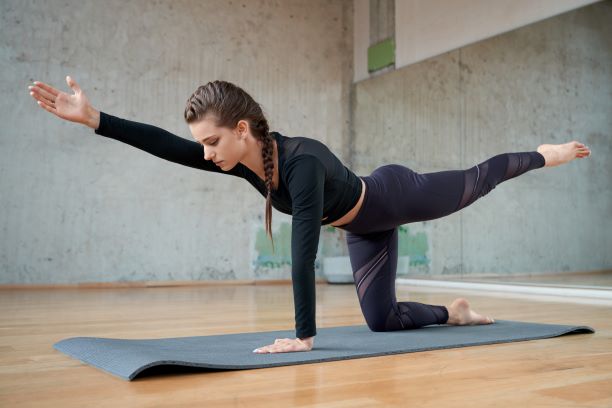Are you doing exercises for low back pain? Low back pain leads to poor control and coordination of your back muscles. Pain shuts down the muscles, leading to atrophy (loss of muscle) and poor movement. Your lumbar multifidus muscle plays an important role in normal spine movement. If you have been dealing with low back pain you likely have atrophied multifidus muscles. Thankfully, exercises for low back pain can help rebuild lost muscle and get you back to moving without pain.

The Basics Exercises for Low Back Pain
The best exercises for low back pain restore control and coordination of the smaller muscles of your spine. Basic exercises initially target your lumbar multifidus and other deep muscles in your back. Perform all exercises in a slow and controlled manner. Don’t rush. Normal breathing is always maintained.
Generally, higher repetitions (10 to 20) are recommended to promote muscle endurance. This is consistent with how these muscles function in everyday life. The following 5 exercises are fundamental for starting a low back exercise program.
Lumbar Multifidus Activation
These are the most basic exercises for low back pain. Begin on all fours with one knee placed on a small pillow or foam Airex pad. Position your shoulders over your hands and hips over your knees. Maintain your spine in a neutral position.
Slowly lift your knee from the floor. Your thigh and hip should move straight up. This small amount of rotation is controlled by your multifidus. Hold this position for 2 to 3 seconds then slowly lower your knee back to the floor. Your foot stays in contact with the floor during the exercise. To progress the exercise, elevate the foot with the knee or increase the hold time to 10 seconds. Perform 10 to 20 repetitions on each side.
2-Leg Bridge
Begin by lying on your back with your hips flexed and feet lined up with your shoulders. Perform the bridge by lifting both hips from the floor. A common mistake is to excessively arch your lower back. Hold the bridge position for 2 to 3 seconds then return to the starting position. Lower your body back down in a slow and controlled manner. Perform 10 to 20 repetitions for multiple sets.
Be sure to achieve the bridge by extending through your hips. If you lack mobility in your hip joints or hip flexor muscles this may lead to compensation through your low back. This can be corrected with manual therapy and hip mobility exercises. You can also try bringing your feet closer together and your knees slightly wider apart. This will allow you to achieve more hip extension range of motion.
Bridge + March
You can progress the standard bridge in many ways. This progression involves an alternating march. Perform a standard bridge and hold the top position. With your hips elevated from the floor, lift one foot 2 to 3 inches. Hold your foot off the floor for 2 to 3 seconds before lowering. Without lowering the hips down to the floor, lift your other foot in the same fashion. Lower your hips back down to the floor to complete the first repetition.
Maintain a level pelvis as one foot is lifted from the floor. This requires activation of your glutes, hamstrings, and lower back muscles. Perform 10 to 12 repetitions on each side for multiple sets.
Bird Dog
Start on your hands and knees with your back flat. Your shoulders are directly over your hands. Your hips are directly over your knees. Slowly raise your left arm and right leg until they are horizontal with your trunk. Maintain a straight line with your trunk, upper extremity, and lower extremity. Avoid trunk rotation.
Also, do not allow your back to sag or arch. Hold this position for 2 to 3 seconds. Then repeat with your right arm and left leg, alternating sides with each repetition. Increase how long you hold each rep to 10 seconds if you want to make it more challenging. Perform 10 to 12 repetitions on each side for multiple sets.
Modified Side Plank
Lie on your side, with your knees comfortably bent. Prop up on your elbow bearing weight through your forearm. Lift your pelvis so the only contact is through your forearm and lower leg. Do not go beyond the neutral position (your body is in a straight line). Do not allow your body to rotate forward or backward. Hold this position for 2 to 3 seconds, and then gently relax down to the starting position. You can make it more challenging by holding the position for 10 seconds. Perform 10 to 12 repetitions on each side.
Develop An Individualized Low Back Exercise Program
Exercises for low back pain often target the lower abdominals, hips, and pelvic muscles. Some refer to this as your “core”. However, it is important to realize that alleviating or preventing low back pain requires an exercise program beyond simply training your core.
Once basic low back and abdominal exercises are performed correctly, progression is needed. Only exercises that integrate the smaller and larger muscles of your trunk with your extremities (advanced core exercises) will restore full function.
Your physical therapist can help you develop an individualized exercise program. Contact us to schedule an appointment with your physical therapist.


